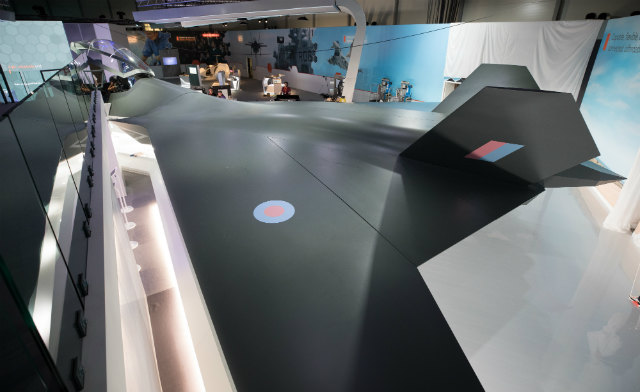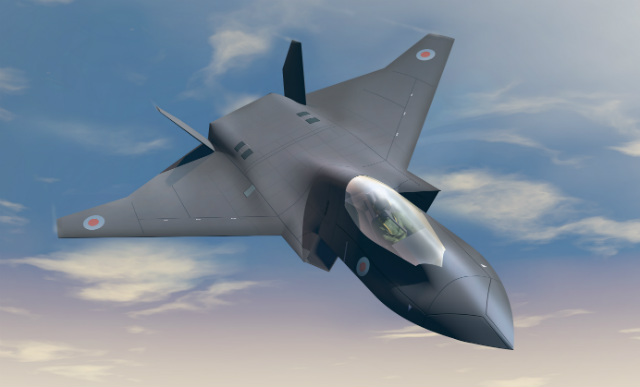A highly ambitious vision of the UK's next-generation fighter was revealed on the opening day of the Farnborough air show, with the Tempest concept adding significant firepower to the Ministry of Defence's new Future Combat Air strategy.
Unveiling a full-scale model of the future platform within BAE Systems' exhibit, defence secretary Gavin Williamson said: "We are entering a dangerous new era of warfare, so our main focus has to be the future. Today, we offer you a glimpse of tomorrow."

BAE Systems
Describing the UK as "a world leader in combat air, combining skills and technology from right across Europe", Williamson says its new strategy provides a template for making "lofty aspirations a reality" when pursuing a future replacement for the Eurofighter Typhoon.
"This is a strategy to keep control of the air, both at home and abroad, to remain a global leader in the sector, support the wider prosperity agenda, and build on key skills across the UK's industrial base," he says.

BAE Systems
The UK's vision for Tempest – a large, twin-engined model with design traits broadly resembling those used on the Lockheed Martin F-22 and sixth-generation fighter concepts – is seen as incorporating a broad range of technologies, including an adaptable propulsion system, and a "virtual" cockpit to be shown on a pilot's helmet-mounted display. An operational platform could be manned or unmanned, and capable of deploying swarming munitions and carrying a laser directed-energy weapon.
A symbol of the work conducted so far as part of a £2 billion ($2.6 billion), 10-year allocation announced within the MoD's 2015 Strategic Defence and Security Review, the concept is result of a collaboration named Team Tempest. Involving BAE, Leonardo, MBDA, Rolls-Royce and the RAF's Rapid Capabilities Office, this embodies a UK capability, but is very much inviting international participation.
Team Tempest's activities will span work across 50-60 national demonstrations, covering aspects such as low-observability, advanced sensors, propulsion and future cockpit design, contained within an existing FCAS technology initiative. The current partners signed a new heads of agreement deal at the show to advance the activity.
"We want new partners as well," Williamson says. "We want to put our world-class skills at the disposal of our friends, by embracing the high-end skills that they also offer and can bring to the table."
Nations including Japan, Sweden and Turkey are among those that the UK would be willing to work with, while the companies behind a separate Franco-German project have called for greater collaboration between European nations, potentially incorporating the UK.
Describing the new Combat Air strategy as a "powerful statement of intent", BAE chief executive Charles Woodburn says the FCAS development initiative is "a great opportunity for us all".
Referring to "an iron-clad commitment to deliver" on the strategy's vision, Williamson says: "A new team is already on the runway. Their timetable is clear: I want to see a business case for the acquisition programme by the end of the year. Early decisions around acquiring next-generation capability will be made by the end of 2020, with final investment decisions by 2025. By 2035, I want to see Tempest flying alongside world-beating Typhoons and [Lockheed] F-35s."
"We are working at pace – that is the mantra of the team," says AVM Simon Rochelle, the RAF's chief of staff, capability. Pointing to a model of "shared equity and shared risk" across the industry partners and the MoD, he adds: "The funding is real."
Key requirements for a future system include its developers' ability to call on spiral development techniques, and to use app-type software to support a system's continued evolution through rapid capability enhancements.
R-R chief engineer Conrad Banks says the company will investigate a full range of technologies for a future propulsion system, including meeting thermal management and cooling needs – potentially via the use of a diverted third stream of air from its gas turbine engines. Other areas of interest include the increased use of composite materials, plus embedded generators, a distortion-tolerant fan system and battery storage technology.
"For the Royal Air Force, it is about taking ownership… it is a unique opportunity to architect a system that will ensure we can sustain the combat air capabilities that are so important today, and continue to control airspace in the future," says chief of the air staff ACM Sir Stephen Hillier. He sees a future strike asset as being a "flexible and agile capability, delivered rapidly, affordably and configurable for a range of future conflicts".
"The UK is fully open to international partnership," Hillier says. "It is an entirely fitting way for the RAF to enter its second century."
Responding to the Tempest concept's unveiling, Airbus says it "is encouraged to see the [UK] government’s financial commitment to the project, which supports the goal of sovereign European defence capability".
"A Future Combat Air System is of utmost importance to Europe’s armed forces and therefore we look forward to continuing collaborative discussions in this area with all relevant European players," Airbus adds.
Get all the coverage from the Farnborough air show on our dedicated event page
Source: FlightGlobal.com



















